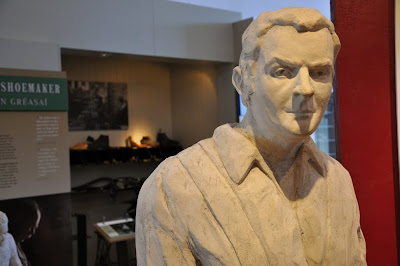Our goal today was relatively straight-forward: drive through Connemara to see some scenery, stop for lunch at the Twelve Bens National Park, visit the National Museum of Country Life, and finish up in Sligo—ready for a huge day tomorrow in (London)Derry.
As much of the scenery was viewed through a bus window, there was not very much opportunity to take pictures. Nevertheless, here are a few sample shots of area scenery (shot last year).


 That is not to say that it was all driving. We started with a stop in Recess—a little town known mostly for a famous gift shop, the Connemara Giant, and the extraordinary events of 1897.
That is not to say that it was all driving. We started with a stop in Recess—a little town known mostly for a famous gift shop, the Connemara Giant, and the extraordinary events of 1897.


After much looking, we finally found a turn-out large enough for the bus that was located near representative samples of turf cutting. Turf (peat) is a moss that lies thick on the ground in much of Ireland. It is extraordinary stuff, sterile (used for bandages during World War I), preservative (it actually preserves human flesh and hair, not to say anything of butter and other perishables), and it burns. Indeed, the Irish have used it for heat and light for hundreds of years. During the second half of the twentieth century, this usage reached a fever pitch when the Irish government established a semi-state body charged with exploiting the bog. Massive turf burning power stations were constructed and the bog was harvested at an astonishing pace, depleting it and destroying whole ecosystems.
As for us, we walked on the bog a bit—a little like a firm waterbed. We also picked up some bricks of dried turf. Light, hard, rough. The following slides show hand-cut turf drying in the sun.

 Our next stop was Twelve Bens were most of the lads did lunch. As for me, I wandered up the hill to see the view and to snap a few pictures. The light was on the poor side, but the view was still wonderful.
Our next stop was Twelve Bens were most of the lads did lunch. As for me, I wandered up the hill to see the view and to snap a few pictures. The light was on the poor side, but the view was still wonderful.
 Connemara behind us, it was on to Castlebar and the National Museum of Folk Life—easily one of my favorite museums in Ireland. We were fortunate to have a guide who showed us many of the highlights, then we wandered around on our own.
Connemara behind us, it was on to Castlebar and the National Museum of Folk Life—easily one of my favorite museums in Ireland. We were fortunate to have a guide who showed us many of the highlights, then we wandered around on our own.




 While I love the museum, I am equally fond of wandering the grounds. There is an eleventh century monastery, complete with round tower, across the street and various art project surround the lake. There are also many plants and flowers to look at. It did not hurt a bit that the sun was warm today, a perfect opportunity to soak up some rays.
While I love the museum, I am equally fond of wandering the grounds. There is an eleventh century monastery, complete with round tower, across the street and various art project surround the lake. There are also many plants and flowers to look at. It did not hurt a bit that the sun was warm today, a perfect opportunity to soak up some rays.






I was surprised to learn that Rhododendron, one of my favorite plants, is a pest in Ireland. It is an invasive weed that is driving out other plants. One person's decorative yard plant is, apparently, another person's plague.


Finally we made our way to Sligo for the night. This county is W.B. Yeats country, so it is hardly surprising that the man himself, decked out in his own poetry, is directly across the street from our hotel. I've always rather liked this statue.

 It seems appropriate to close with a few lines of Yeats...
It seems appropriate to close with a few lines of Yeats...I will arise and go now, and go to Innisfree,
And a small cabin build there, of clay and wattles made:
Nine bean-rows will I have there, a hive for the honeybee,
And live alone in the bee-loud glade.
And I shall have some peace there, for peace comes dropping slow,
Dropping from the veils of the morning to where the cricket sings;
There midnight's all a glimmer, and noon a purple glow,
And evening full of the linnet's wings.
I will arise and go now, for always night and day
I hear lake water lapping with low sounds by the shore;
While I stand on the roadway, or on the pavements grey,
I hear it in the deep heart's core.
—W.B. Yeats


No comments:
Post a Comment